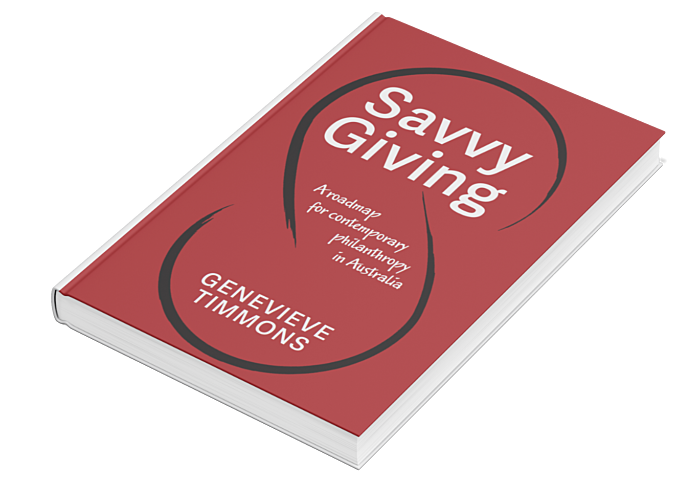
Why meetings can harm employee well-being
Posted on 10 Dec 2025
Anyone working in an organisation knows it: meetings follow one after another at a frantic pace. On…
Posted on 12 Sep 2024
By Genevieve Timmons

Philanthropic expert Genevieve Timmons has updated her book Savvy Giving for a new decade. In this extract from the 2nd edition of her groundbreaking review of the philanthropic scene in Australia, Timmons offers a roadmap of contemporary philanthropy.
The contemporary philanthropy ecosystem in Australia today has moved on from the traditional perception that philanthropic giving is in the hands of a few wealthy individuals. In the context of a civil society, this ecosystem is now becoming formally visible, with resources, connections and relationships at work to contribute to the wellbeing of society. With increased public recognition comes the challenge to meet its full potential and to recognise how the fingerprints of many people currently influence giving.

Philanthropic giving was once in the hands of the few, arranged behind closed doors, and largely unreported and unaccountable other than for legal compliance and tax purposes. The philanthropist was a rare individual, often distant and mysterious. Today, the visibility and accountability of philanthropic giving is up for public scrutiny due to rapid expansion in numbers and dollars, advances in technology and communication, increased regulation and compliance, and a maturing not-for-profit sector which is looking for rigour and confidence for all involved.
The focus on people with high net worth led to long-held assumptions that philanthropy is only for the wealthy. But today, philanthropic giving has become democratised. People with moderate amounts of money are also stepping up to be part of contemporary philanthropy, in whatever way and at whatever scale their modest incomes allow.
As this groundswell of deliberate generosity advances, so too does the enthusiasm to see money as a currency for connection and agency, a means for personal expression and power, and a way to influence and shape the world in which we want to live. This welcome progress has come with even more complex and urgent questions and challenges, spurred on by a search for best approaches to organised giving and a commitment to optimal impact.

As the work of philanthropy becomes more publicly visible, the complexity of dynamic networks and shared agendas for many funders can aptly be described as an ecosystem.
Characteristics which qualify this description are where funders are seeking coherence in their approach, exploring possibilities for collaboration, sharing learning and agreeing on standards and codes of practice. Support for shared platforms and specialist networks such as Philanthropy Australia are amplifying collective engagement and collaboration around often complex social challenges. This is how contemporary philanthropy is legitimately evolving as an ecosystem.
People are taking their place in the philanthropic ecosystem, regardless of their role or focus for granting. The context is relevant for new and old money, and small- or large-scale giving, and porous borders encourage new people to be part of structured giving. Ambitions for impact are shared through interconnections and alignment. Wherever funders operate in this ecosystem, the common challenge is to recognise the place they occupy and the shared influence that can be brought to bear in the interests of wider society.
As philanthropic practice within the ecosystem evolves, both nationally and internationally, attention is being paid not only to where philanthropic money comes from and where it lands, but also how people manage, coordinate and influence the work collectively, interrelating and interacting with each other as accepted good practice. It is also recognised that for a healthy ecosystem to flourish, the emphasis needs to be on trust, shared values and common goals to effectively leverage resources and amplify impact. Self-organising with emphasis on connection and reciprocity rather than competition and extraction are hallmarks of a healthy ecosystem.

Everyone comes to the work of philanthropic giving from different places and for different reasons, and often with startlingly different experience and capacity. Some are motivated by tax burden relief or an eagerness to share personal wealth. Others follow in the footsteps of previous generations with inherited wealth, looking for a way to use their skills for a meaningful purpose, feeding a hunger to do good, or even allaying a fear of not having done enough. For most, there is an innate sense of the value of giving, whether it’s their own money or managing other people’s wealth. For many, promoting a culture of generosity in an increasingly consumer-driven world is recognised as more important than ever. As opportunities to take on formal roles rapidly expand in philanthropic work, people are bringing skills from business, not-for-profits, government and academies, shifting career trajectory to join a growing and changing field with a perceived heightened socio-economic impact.
"This is an important time for not-for-profits to step up and emphasise their critical role in shaping a better world with philanthropic dollars."
Here is a snapshot of the key players in the philanthropy ecosystem, identifying the source of the dollars, the place for managing distribution of giving where the money is brought to life through initiatives that deliver benefit to society, and where added value is provided.
Effective giving starts with acknowledging people at every level of this ecosystem, and building engagement and recognising complementarity wherever appropriate. While many people share a commitment to the culture of effective giving, this shared focus in the ecosystem relies on efficiency, creativity and continual learning. The assumption is that all players are keen to ensure that optimal results are delivered from every social dollar spent.
Wherever people appear in the ecosystem, and whatever the specific role, influence on the quality and style of philanthropy is wielded at numerous levels.
This is an important time for not-for-profits to step up and emphasise their critical role in shaping a better world with philanthropic dollars. This ‘philanthropic ecosystem’ model maps out the place and essential contribution of not-for-profit organisations as value creators in the contemporary landscape for philanthropic giving in Australia. The framework also puts into sharp focus the fact that not-for-profit organisations put philanthropic dollars to work and deliver outcomes for funders, and without them, all we have is money.
Other key influencers actively engaged in philanthropic funding are also identified, opening up possibilities for wider and deeper partnerships and exchange with all parties involved. By noting the landscape and recognising others actively engaged in the ecosystem, not-for-profit organisations strengthen their role and relevance as funding partners, and broaden the traditional view of philanthropy as led and defined by a small group of philanthropic funders.
This is an edited extract from Genevieve Timmons book Savvy Giving, first published in 2013 and recently updated. The 2nd edition, published by the Australian Communities Foundation (ACF), will be launched among ACF fundholders and friends in Melbourne on Thursday September 19.

Posted on 10 Dec 2025
Anyone working in an organisation knows it: meetings follow one after another at a frantic pace. On…

Posted on 10 Dec 2025
As a qualified yoga instructor who learned the practice in her hometown of Mumbai, Ruhee Meghani…

Posted on 10 Dec 2025
Community Directors trainer Jon Staley knows from first-hand experience the cost of ignoring…

Posted on 10 Dec 2025
Stressed, overwhelmed, exhausted… if you’re on a not-for-profit board and these words sound…

Posted on 10 Dec 2025
The Institute of Community Directors Australia trains over 22,000 people each year, which gives us…

Posted on 03 Dec 2025
Many not-for-profit (NFP) board members in Australia are burnt out, overwhelmed and considering…

Posted on 26 Nov 2025
A roll call of Victoria’s brightest future leaders has graduated from a testing and inspiring…

Posted on 12 Nov 2025
At the Institute of Community Directors Australia, we believe that stronger communities make a…

Posted on 12 Nov 2025
Like many Community Directors members, Hazel Westbury is a community leader who isn’t easily…

Posted on 11 Nov 2025
I’ve seen what happens when fear of conflict wins out over taking a principled stand.

Posted on 11 Nov 2025
‘It’s not a question of enough, pal. It’s a zero-sum game. Somebody wins and somebody loses’.

Posted on 11 Nov 2025
Progressive economic Richard Denniss believes the constant hunt by governments for the political…